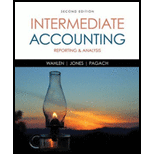
Intermediate Accounting: Reporting and Analysis
2nd Edition
ISBN: 9781285453828
Author: James M. Wahlen, Jefferson P. Jones, Donald Pagach
Publisher: Cengage Learning
expand_more
expand_more
format_list_bulleted
Question
Chapter 1, Problem 7C
To determine
Write a brief report for your friend that provides two interesting and important pieces of information about Corporation S from the major financial statements and management discussion and analysis report.
Expert Solution & Answer
Trending nowThis is a popular solution!

Students have asked these similar questions
I am looking for the correct answer to this General accounting question with appropriate explanations.
What is the depreciation expense in year 2?
Hoe much sold for to achieve the desired markup ?
Chapter 1 Solutions
Intermediate Accounting: Reporting and Analysis
Ch. 1 - Prob. 1GICh. 1 - Prob. 2GICh. 1 - Prob. 3GICh. 1 - Prob. 4GICh. 1 - Prob. 5GICh. 1 - Prob. 6GICh. 1 - Prob. 7GICh. 1 - What are the two primary forces determining the...Ch. 1 - Prob. 9GICh. 1 - Prob. 10GI
Ch. 1 - Prob. 11GICh. 1 - Prob. 12GICh. 1 - Prob. 13GICh. 1 - Prob. 14GICh. 1 - Prob. 15GICh. 1 - Prob. 16GICh. 1 - Prob. 17GICh. 1 - Prob. 18GICh. 1 - Prob. 19GICh. 1 - Prob. 20GICh. 1 - Prob. 21GICh. 1 - Prob. 22GICh. 1 - Prob. 23GICh. 1 - Why do accountants have to be ethical in their...Ch. 1 - Prob. 25GICh. 1 - Prob. 1ECh. 1 - Prob. 1CCh. 1 - Prob. 2CCh. 1 - Prob. 3CCh. 1 - Prob. 4CCh. 1 - One of your friends remarks, I understand that...Ch. 1 - Prob. 6CCh. 1 - Prob. 7CCh. 1 - Prob. 8CCh. 1 - Prob. 9CCh. 1 - Prob. 12CCh. 1 - Prob. 13CCh. 1 - Codification Situation You are conducting an...
Knowledge Booster
Similar questions
- Can you demonstrate the accurate steps for solving this financial accounting problem with valid procedures?arrow_forwardWhat was the net cash flow provided by opening activities for horizon industries?arrow_forwardBlue Oak, Inc., uses direct labor hours to allocate overhead costs. If Blue Oak estimates $60,000 of overhead and 75,000 hours of direct labor this period, the overhead applied when 6,000 direct labor hours are used should be_____. a. $4,200.33 b. $4,800.00 c. $5,125.48 d. $5,865.75arrow_forward
arrow_back_ios
SEE MORE QUESTIONS
arrow_forward_ios
Recommended textbooks for you
 Intermediate Accounting: Reporting And AnalysisAccountingISBN:9781337788281Author:James M. Wahlen, Jefferson P. Jones, Donald PagachPublisher:Cengage Learning
Intermediate Accounting: Reporting And AnalysisAccountingISBN:9781337788281Author:James M. Wahlen, Jefferson P. Jones, Donald PagachPublisher:Cengage Learning College Accounting, Chapters 1-27AccountingISBN:9781337794756Author:HEINTZ, James A.Publisher:Cengage Learning,
College Accounting, Chapters 1-27AccountingISBN:9781337794756Author:HEINTZ, James A.Publisher:Cengage Learning, Financial Reporting, Financial Statement Analysis...FinanceISBN:9781285190907Author:James M. Wahlen, Stephen P. Baginski, Mark BradshawPublisher:Cengage Learning
Financial Reporting, Financial Statement Analysis...FinanceISBN:9781285190907Author:James M. Wahlen, Stephen P. Baginski, Mark BradshawPublisher:Cengage Learning- Century 21 Accounting Multicolumn JournalAccountingISBN:9781337679503Author:GilbertsonPublisher:Cengage
 Financial Accounting: The Impact on Decision Make...AccountingISBN:9781305654174Author:Gary A. Porter, Curtis L. NortonPublisher:Cengage Learning
Financial Accounting: The Impact on Decision Make...AccountingISBN:9781305654174Author:Gary A. Porter, Curtis L. NortonPublisher:Cengage Learning

Intermediate Accounting: Reporting And Analysis
Accounting
ISBN:9781337788281
Author:James M. Wahlen, Jefferson P. Jones, Donald Pagach
Publisher:Cengage Learning

College Accounting, Chapters 1-27
Accounting
ISBN:9781337794756
Author:HEINTZ, James A.
Publisher:Cengage Learning,

Financial Reporting, Financial Statement Analysis...
Finance
ISBN:9781285190907
Author:James M. Wahlen, Stephen P. Baginski, Mark Bradshaw
Publisher:Cengage Learning

Century 21 Accounting Multicolumn Journal
Accounting
ISBN:9781337679503
Author:Gilbertson
Publisher:Cengage

Financial Accounting: The Impact on Decision Make...
Accounting
ISBN:9781305654174
Author:Gary A. Porter, Curtis L. Norton
Publisher:Cengage Learning
